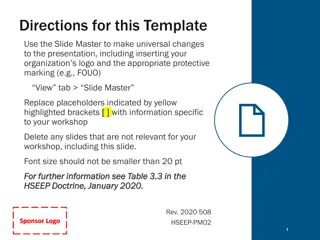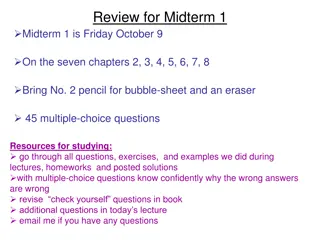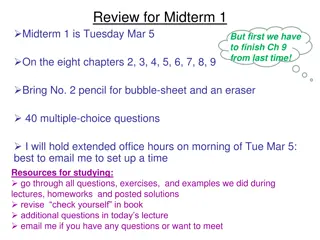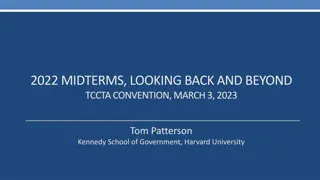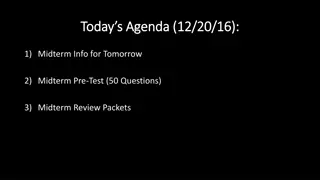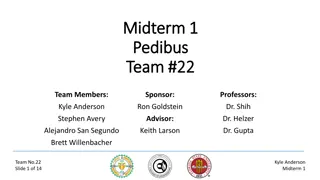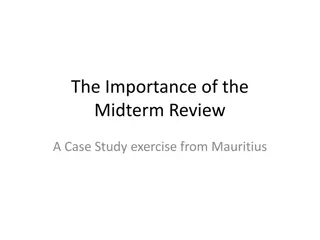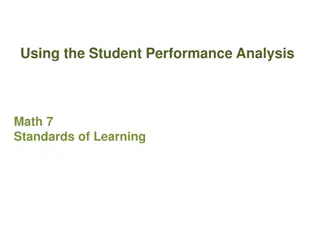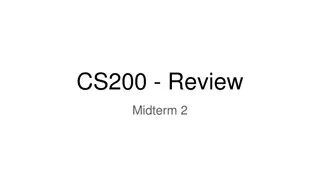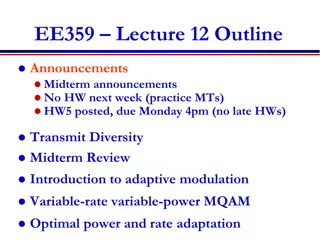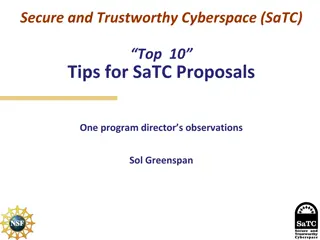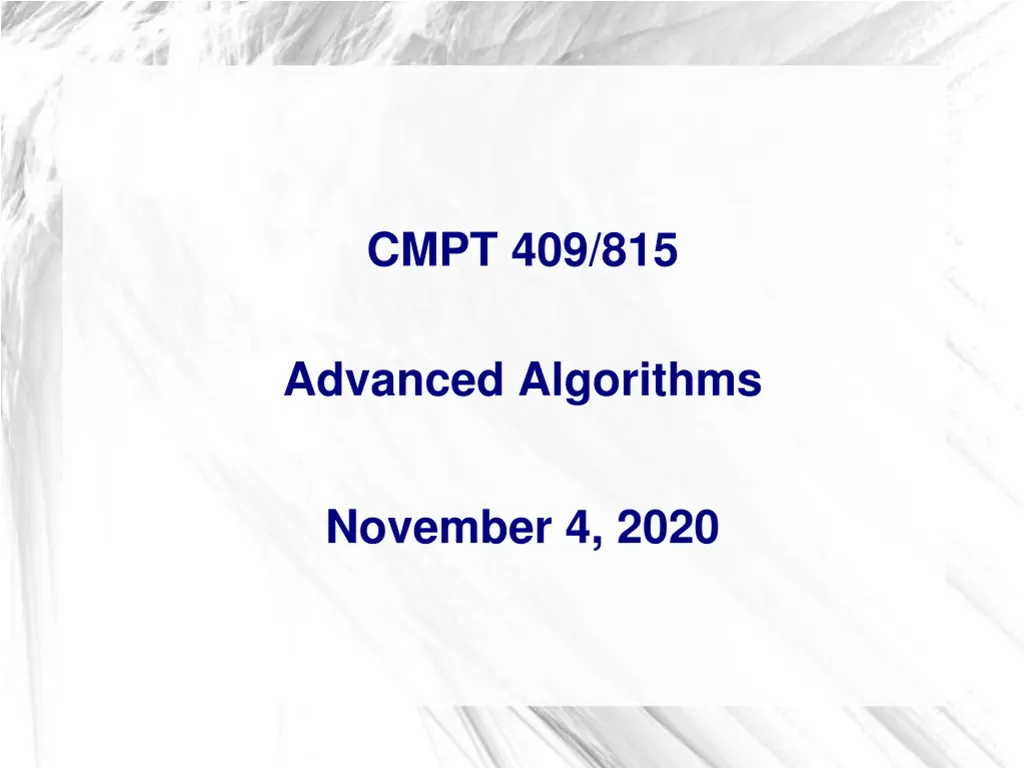
Advanced Algorithms - k-Min-Cut Algorithm and Theorems
Delve into the k-Min-Cut algorithm, solving problems from a midterm, and exploring the theorems related to minimum cuts in connected graphs. Learn about Karger's Min-Cut algorithm, its input, output, and how it works step by step. Understand how partitions are formed and cut sizes are determined in graphs. Discover the fascinating world of graph algorithmic theory.
Download Presentation

Please find below an Image/Link to download the presentation.
The content on the website is provided AS IS for your information and personal use only. It may not be sold, licensed, or shared on other websites without obtaining consent from the author. If you encounter any issues during the download, it is possible that the publisher has removed the file from their server.
You are allowed to download the files provided on this website for personal or commercial use, subject to the condition that they are used lawfully. All files are the property of their respective owners.
The content on the website is provided AS IS for your information and personal use only. It may not be sold, licensed, or shared on other websites without obtaining consent from the author.
E N D
Presentation Transcript
CMPT 409/815 Advanced Algorithms November 4, 2020
Solving some problems from the midterm
Kargers Min-Cut algorithm Input: A graph G=(V,E) Output: minimum k-cut in G A partition of the vertices into k non-empty parts such that the edges in the k- cut is minimal
Kargers Min-Cut algorithm Input: A connected graph G=(V,E) Output: Min-Cut(G) Algorithm: While G has more than 2 vertices do 1. Choose a random edge e E 2. Contract e Return the partition corresponding to the two remaining supernodes.
Kargers Min-Cut algorithm Example: ab abc ab a (a,b) (e,f) (ab,c) b c c c f f e e ef ef The partition is S = {a,b,c} V\S = {e,f} The cut size is E(S, V\S) = 4
Kargers Min-Cut algorithm Input: A connected graph G=(V,E) Output: Min-Cut(G) Algorithm: While G has more than 2 vertices do 1. Choose a random edge e E 2. Contract e Return the partition corresponding to the two remaining supernodes.
Kargers Min-Cut algorithm Theorem: Let (S, V\S) be a partition corresponding to the minimum cut in G. 2 Then Pr ??????? ? ??????? ? ?? ????????? ?(? 1). Proof: Let C = E(S, V\S) be the edges in this min-cut. Observation 1: If the algorithm never chooses an edge in C, then it returns (S, V\S) ? ?. Pr ????? ????? ?? ??? ?? ? = 1 Observation 2: |C| <= min-deg(G) Observation 3: |E| >= min-deg(G)*n/2 ? ? 1 ??? deg(?) ??? deg ? ?/2=? 2 ?. Pr ????? ???? ?? ??? ?? ? = 1
Kargers Min-Cut algorithm Theorem: Let (S, V\S) be a partition corresponding to the minimum cut in G. 2 Then Pr ??????? ? ??????? ? ?? ????????? ?(? 1). Proof: Thus far we showed that ? ? 1 ??? deg(?) ??? deg ? ?/2=? 2 ?. Pr ????? ???? ?? ??? ?? ? = 1 After contracting the first edge, we get a graph on n-1 vertices ??? deg(? ) ??? deg ? (? 1)/2= 1 ? 1=? 3 2 ? 1. Pr ?????? ???? ?? ??? ?? ? 1 and so on. Therefore, Pr ? ? ??????? ? ? ????? ?? ???? ???? ? ? 2 ? 3 ? 1. ? 4 ? 2 2 4 1 2 ? 3= ?(? 1)
Min-k-Cut algorithm Run Karger s algorithm, and stop when k supervertices are left Example k=3: ab ab a (a,b) (e,f) b c c c f f e e ef The partition is V1 = {a,b} V2 = {c} V3 = {e,f}
Min-k-Cut algorithm Input: A connected graph G=(V,E) Output: Min-k-Cut(G) Algorithm: While G has more than k vertices do 1. Choose a random edge e E 2. Contract e Return the partition corresponding to the remaining k supernodes.
Min-k-Cut algorithm Theorem: Let C be the edges in some min-k-cut (V1,V2 Vk). 1 Then Pr ??????? ? ??????? ? ?? ????????? ??. By repeating O(nk) times we will find the optimal k- cut Proof: Let C be the edges in some min-k-cut. Observation 1: If the algorithm never chooses an edge in C, then it returns this partition ? ?. Pr ????? ????? ?? ??? ?? ? = 1 Observation 2: |C| <= min-deg(G) Observation 3: |E| >= min-deg(G)*n/2 ? ? 1 ??? deg(?) ??? deg ? ?/2=? 2 ?. Pr ????? ???? ?? ??? ?? ? = 1
Min-k-Cut algorithm Theorem: Let C be the edges in some min-k-cut (V1,V2 Vk). 1 Then Pr ??????? ? ??????? ? ?? ????????? ??. Proof: Thus far we showed that ? ? 1 ??? deg(?) ??? deg ? ?/2=? 2 ?. Pr ????? ???? ?? ??? ?? ? = 1 After contracting the first edge, we get a graph on n-1 vertices ??? deg(? ) ??? deg ? (? 1)/2= 1 ? 1=? 3 2 ? 1. Pr ?????? ???? ?? ??? ?? ? 1 and so on. Therefore, Pr ? ? ??????? ? ? ????? ?? ???? ???? ? ? 2 ? 3 ? 1. ? 4 2 1 ? ? 2 ?+2 ?+1= 1 2 ? ?! ?? ? ? 1 ? ?+1
Max-Cut is preserved for random subgraph
Max-Cut is preserved for random subgraph Given a graph G=(V,E) max-cut is the defined as max-cut(G) = maxS,V\S| E(S,V\S) | / |E| Let H=(V,EH) be obtained from G be removing each edge with probability . Prove 1) If max-cut(G)=1, then max-cut(H)=1 2) If |E|=|EG|=m, then Pr[| |EH|-m/2 | < eps m] > 1-e-n 3) max-cut(H) is almost equal to max-cut(G).
Max-Cut is preserved for random subgraph Given a graph G=(V,E) max-cut is the defined as max-cut(G) = maxS,V\S| E(S,V\S) | / |E| Let H=(V,EH) be obtained from G be removing each edge with probability . Prove If max-cut(G)=1, then max-cut(H)=1 Easy: if max-cut(G)=1, then there is a bi-partition (S,V\S) of V such that all edges of G have one end point in each part. The same bipartition also works for H.
Max-Cut is preserved for random subgraph Given a graph G=(V,E) max-cut is the defined as max-cut(G) = maxS,V\S| E(S,V\S) | / |E| Let H=(V,EH) be obtained from G be removing each edge with probability . Prove 2) If |E|=|EG|=m, then Pr[| |EH|-m/2 | < m] > 1-2-n Proof: This is just an application of Chernoff bound. EH is the sum of all indicator random variables saying that an edge survived Pr[| |EH|-m/2 | > m] > 1-e- 2m/6>1-2-n (assuming that ?2m>6n, which holds for m>n1.5).
Max-Cut is preserved for random subgraph Given a graph G=(V,E) max-cut is the defined as max-cut(G) = maxS,V\S| E(S,V\S) | / |E| Let H=(V,EH) be obtained from G be removing each edge with probability . Prove: max-cut(H) > max-cut(G)- with high probability Proof: This is just another of Chernoff bound. Fix an optimal cut in G. Let s say the edges in the cut are some set C. Note that |C|>= m/2. Denote by CH the edges of C that survive the random removal. Pr[ |CH|-|C| | > |C|] > 1-e- 2|C|/6 > 1-e- 2m/12>1-2-n In particular, with this probability |CH| > |C|- |C|. Normalizing by mH, + the previous item max-cut(H) >= max-cut(G)-2
Max-Cut is preserved for random subgraph Prove: max-cut(H) < max-cut(G)+ with high probability Proof: This is yet another of Chernoff bound + union bound Fix any cut in G. Let s say the edges in the cut are some set C. Note that if |C|<m/4, then the corresponding cut mot be max-cut in H anyway. Denote by CH the edges of C that survive the random removal. Pr[ |CH|-|C| | > ?|C|] > 1-e- 2|C|/6 > 1-e- 2m/12>1-2-3n (again, assuming that In particular, with this probability |CH| < |C|+ |C|. Normalizing by mH, + the previous item this-cut(H) <= this-cut(G)+2 Taking union bound over 2n cuts all cuts give us the result
Questions? Comments?





